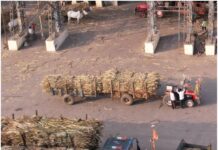The United States Department of Agriculture (USDA) expects the Philippines’ raw sugar production in the current crop year to hold steady at 2.09 million metric tons (MT), which is nine percent higher than the government’s own projection, reports Manila Bulletin.
In a Nov. 26 report, the USDA’s Foreign Agricultural Service (FAS) said output for marketing year (MY) 2026 is likely to remain unchanged from the previous MY’s 2.09 million MT. The country recently shifted its MY cycle to run from Oct. 1 to Sept. 30. Under the former Sept. 1–Aug. 31 schedule, the USDA still projected flat production.
The agency attributed the stagnant output to the spread of the red-stripe soft scale insect (RSSI), a pest capable of reducing sugar content by up to 50 percent. On Sept. 11, the Sugar Regulatory Administration (SRA) reported that RSSI had affected around 6,333 hectares (ha) of sugarcane farms. Negros Island—which produces 65 percent of the country’s sugar—recorded infestations in 5,000 ha, or 79 percent of the total impacted area.
According to the USDA, the pest is “affecting parts of Negros Island, especially the northern areas, where sugarcane is expected to show lower sucrose levels depending on how severe the infestation is.” It added that “better crop conditions in southern Negros are likely to offset losses from the affected northern region.”
In its Sugar Order (SO) No. 1 issued on Sept. 17, the SRA also cited RSSI as a key reason for estimating raw sugar output at a lower 1.92 million MT. The agency further warned that recent heavy rains in Negros may weigh on production.
The USDA, however, does not foresee a decline, pointing to the expansion of sugarcane cultivation in Mindanao, which includes areas converted from banana plantations. It expects the total sugarcane area to rise to 400,000 ha from 392,356 ha last year, with cane output increasing to 25 million MT from 24 million MT.
On the demand side, the USDA projects consumption to stay flat at 2.2 million MT, citing high prices and broader economic pressures. Industrial users account for 50 percent of demand, households for 32 percent, and institutional buyers for 18 percent.
As earlier announced by the SRA, there will be no new sugar imports until the end of the ongoing milling season in the second quarter of 2026. Still, the USDA expects the Philippines to bring in around 194,000 MT of refined sugar, carried over from the previously approved import volume of 424,000 MT for MY 2025.
The agency said the country is not expected to export sugar this MY, in line with SO 1, which directs that all production be used domestically. It stated that the policy “shows the government’s aim to secure enough supply for local markets.” However, it noted that high stock levels make it possible that the SRA “will announce another import or export program, as it has done in the past two years.”

















